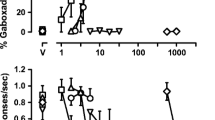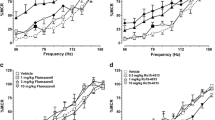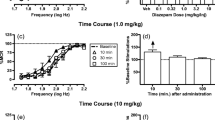Abstract
Rationale
Assays of schedule-controlled responding can be used to characterize the pharmacology of benzodiazepines and other GABAA receptor modulators, and are sensitive to changes in drug effects that are related to physical dependence.
Objective
The present study used this approach to investigate the role of GABAA receptor subtypes in mediating dependence-like effects following benzodiazepine administration.
Methods
Squirrel monkeys (n = 6) were trained on a fixed-ratio schedule of food reinforcement. Initially, the response rate-decreasing effects of chlordiazepoxide (0.1–10 mg/kg; nonselective GABAA receptor agonist), zolpidem (0.032–1.0 mg/kg; α1 subunit-containing GABAA subtype-preferring agonist), and HZ-166 (0.1–10 mg/kg; functionally selective α2 and α3 subunit-containing GABAA receptor agonist) were assessed. Next, acute dependence-like effects following single injections of chlordiazepoxide, zolpidem, and HZ-166 were assessed with flumazenil (0.1–3.2 mg/kg; nonselective GABAA receptor antagonist). Finally, acute dependence-like effects following zolpidem administration were assessed with βCCt and 3-PBC (0.1–3.2 mg/kg and 0.32–10 mg/kg, respectively; α1 subunit-containing GABAA receptor antagonists).
Results
Chlordiazepoxide, zolpidem, and HZ-166 produced dose- and time-dependent decreases in response rates, whereas flumazenil, βCCT, and 3-PBC were ineffective. After the drug effects waned, flumazenil produced dose-dependent decreases in response rates following administration of 10 mg/kg chlordiazepoxide and 1.0 mg/kg zolpidem, but not following any dose of HZ-166. Further, both βCCT and 3-PBC produced dose-dependent decreases in response rates when administered after 1.0 mg/kg zolpidem.
Conclusions
These data raise the possibility that α1 subunit-containing GABAA receptors play a major role in physical dependence-related behaviors following a single injection of a benzodiazepine.



Similar content being viewed by others
References
Adams JU, Holtzman SG (1990) Pharmacologic characterization of the sensitization to the rate-decreasing effects of naltrexone induced by acute opioid pretreatment in rats. J Pharmacol Exp Ther 253:483–489
Atack JR, Wafford KA, Tye SJ, Cook SM, Sohal B, Pike A, Sur C, Melillo D, Bristow L, Bromidge F, Ragan I, Kerby J, Street L, Carling R, Castro JL, Whiting P, Dawson GR, McKernan RM (2006) TPA023 [7-(1,1 dimethylethyl)-6-(2-ethyl-2H-1,2,4-triazol-3-ylmethoxy)-3-(2-fluorophenyl)-1,2,4-triazolo[4,3-b]pyridazine], an agonist selective for alpha2- and alpha3-containing GABAA receptors, is a nonsedating anxiolytic in rodents and primates. J Pharmacol Exp Ther 316:410–422
Bronson ME (1994) Chlordiazepoxide, but not bretazenil, produces acute dependence, as evidenced by disruptions in schedule-controlled behavior. Pharmacol Biochem Behav 48:397–401
Collinson N, Kuenzi FM, Jarolimek W, Maubach KA, Cothliff R, Sur C, Smith A, Otu FM, Howell O, Atack JR, McKernan RM, Seabrook GR, Dawson GR, Whiting PJ, Rosahl TW (2002) Enhanced learning and memory and altered GABAergic synaptic transmission in mice lacking the alpha 5 subunit of the GABAA receptor. J Neurosci 22:5572–5580
Crestani F, Keist R, Fritschy JM, Benke D, Vogt K, Prut L, Blüthmann H, Möhler H, Rudolph U (2002) Trace fear conditioning involves hippocampal alpha5 GABAA receptors. Proc Natl Acad Sci U S A 99:8980–8985
Elliot EE, White JM (2000) Precipitated and spontaneous withdrawal following administration of lorazepam but not zolpidem. Pharmacol Biochem Behav 66:361–369
Fischer BD, Licata SC, Edwankar RV, Wang ZJ, Huang S, He X, Yu J, Zhou H, Johnson EM Jr, Cook JM, Furtmüller R, Ramerstorfer J, Sieghart W, Roth BL, Majumder S, Rowlett JK (2010) Anxiolytic-like effects of 8-acetylene imidazobenzodiazepines in a rhesus monkey conflict procedure. Neuropharmacology 59:612–618
Gerak LR, France CP (1997) Repeated administration of flumazenil does not alter its potency in modifying schedule-controlled behavior in chlordiazepoxide treated rhesus monkeys. Psychopharmacology 131:64–70
Griffiths RR, Weerts EM (1997) Benzodiazepine self-administration in humans and laboratory animals—implications for problems of long-term use and abuse. Psychopharmacology 134:1–37
Griffiths RR, Sannerud CA, Ator NA, Brady JV (1992) Zolpidem behavioral pharmacology in baboons: self-injection, discrimination, tolerance and withdrawal. J Pharmacol Exp Ther 260:1199–1208
Harvey SC, Foster KL, McKay PF, Carroll MR, Seyoum R, Woods JE 2nd, Grey C, Jones CM, McCane S, Cummings R, Mason D, Ma C, Cook JM, June HL (2002) The GABAA receptor alpha1 subtype in the ventral pallidum regulates alcohol-seeking behaviors. J Neurosci 22:3765–3775
Holm KJ, Goa KL (2000) Zolpidem: an update of its pharmacology, therapeutic efficacity and tolerability in the treatment of insomnia. Drugs 59:865–889
Holtzman SG, Villarreal JE (1973) Operant behavior in the morphine-dependent rhesus monkey. J Pharmacol Exp Ther 184:528–541
Kliethermes CL, Metten P, Belknap JK, Buck KJ, Crabbe JC (2004) Selection for pentobarbital withdrawal severity: correlated differences in withdrawal from other sedative drugs. Brain Res 1009:17–25
Knabl J, Witschi R, Hösl K, Reinold H, Zeilhofer UB, Ahmadi S, Brockhaus J, Sergejeva M, Hess A, Brune K, Fritschy J-M, Rudolph U, Möhler H, Zeilhofer HU (2008) Reversal of pathological pain through specific spinal GABAA receptor subtypes. Nature 451:330–334
Licata SC, Platt DM, Cook JM, Sarma PV, Griebel G, Rowlett JK (2005) Contribution of GABAA receptor subtypes to the anxiolytic-like, motor, and discriminative stimulus effects of benzodiazepines: studies with the functionally selective ligand SL651498 [6-fluoro-9-methyl-2-phenyl-4-(pyrrolidin-1-yl-carbonyl)-2,9-dihydro-1H-pyridol[3,4-b]indol-1-one]. J Pharmacol Exp Ther 313:1118–1125
Licata SC, Rowlett JK (2008) Abuse and dependence liability of benzodiazepine-type drugs: GABAA receptor modulation and beyond. Pharmacol Biochem Behav 90:74–89
Löw K, Crestani F, Keist R, Benke D, Brunig I, Benson JA, Fritschy JM, Rulicke T, Bluethmann H, Mohler H, Rudolph U (2000) Molecular and neuronal substrate for the selective attenuation of anxiety. Science 290:131–134
Lukas SE, Griffiths RR (1982) Precipitated withdrawal by a benzodiazepine receptor antagonist (Ro 15–1788) after 7 days of diazepam. Science 217:1161–1163
Lukas SE, Griffiths RR (1984) Precipitated diazepam withdrawal in baboons: effects of dose and duration of diazepam exposure. Eur J Pharmacol 100:163–171
McKernan RM, Rosahl TW, Reynolds DS, Sur C, Wafford KA, Atack JR, Farrar S, Myers J, Cook G, Ferris P, Garrett L, Bristow L, Marshall G, Macaulay A, Brown N, Howell O, Moore KW, Carling RW, Street LJ, Castro JL, Ragan CI, Dawson GR, Whiting PJ (2000) Sedative but not anxiolytic properties of benzodiazepines are mediated by the GABAA receptor α1 subtype. Nat Neurosci 3:587–592
McMahon LR, France CP (2002) Daily treatment with diazepam differentially modifies sensitivity to the effects of gamma-aminobutyric acid(A) modulators on schedule-controlled responding in rhesus monkeys. J Pharmacol Exp Ther 300:1017–1025
Mirza NR, Nielsen EØ (2006) Do subtype-selective gamma-aminobutyric acid A receptor modulators have a reduced propensity to induce physical dependence in mice? J Pharmacol Exp Ther 316:1378–1385
Olsen RW, Sieghart W (2008) International Union of Pharmacology. LXX. Subtypes of gamma-aminobutyric acid(A) receptors: classification on the basis of subunit composition, pharmacology, and function. Update. Pharmacol Rev 60:243–260
Paronis CA, Bergman J (1999) Apparent pA2 values of benzodiazepine antagonists and partial agonists in monkeys. J Pharmacol Exp Ther 290:1222–1229
Perrault G, Morel E, Sanger DJ, Zivkovic B (1992) Lack of tolerance and physical dependence upon repeated treatment with the novel hypnotic zolpidem. J Pharmacol Exp Ther 263:298–303
Platt DM, Carey G, Spealman RD (2011). Models of neurological disease (substance abuse): self-administration in monkeys. Curr Protoc Pharmacol. Chapter 10:Unit10.5
Pritchett DB, Lüddens H, Seeburg PH (1989) Type I and type II GABAA-benzodiazepine receptors produced in transfected cells. Science 245:1389–1392
Rowlett JK, Platt DM, Lelas S, Atack JR, Dawson GR (2005) Different GABAA receptor subtypes mediate the anxiolytic, abuse-related, and motor effects of benzodiazepine-like drugs in primates. Proc Natl Acad Sci U S A 102:915–920
Rudolph U, Crestani F, Benke D, Brunig I, Benson JA, Fritschy JM, Martin JR, Bluethmann H, Mohler H (1999) Benzodiazepine actions mediated by specific gamma-aminobutyric acid(A) receptor subtypes. Nature 401:796–800
Rudolph U, Crestani F, Möhler H (2001) GABAA receptor subtypes: dissecting their pharmacological functions. Trends Pharmacol Sci 22:188–194
Savić MM, Majumder S, Huang S, Edwankar RV, Furtmüller R, Joksimović S, Clayton T Sr, Ramerstorfer J, Milinković MM, Roth BL, Sieghart W, Cook JM (2010) Novel positive allosteric modulators of GABAA receptors: do subtle differences in activity at alpha1 plus alpha5 versus alpha2 plus alpha3 subunits account for dissimilarities in behavioral effects in rats? Prog Neuropsychopharmacol Biol Psychiatry 34:376–386
Smith AJ, Alder L, Silk J, Adkins C, Fletcher AE, Scales T, Kerby J, Marshall G, Wafford KA, McKernan RM, Atack JR (2001) Effect of α subunit on allosteric modulation of ion channel function in stably expressed human recombinant γ aminobutyric acidA receptors determined using 36Cl ion flux. Mol Pharmacol 59:1108–1118
Spealman RD (1986) Disruption of schedule-controlled behavior by Ro 15–1788 one day after acute treatment with benzodiazepines. Psychopharmacology 88:398–400
Tan KR, Brown M, Labouèbe G, Yvon C, Creton C, Fritschy JM, Rudolph U, Lüscher C (2010) Neural bases for addictive properties of benzodiazepines. Nature 463:769–774
Vanover KE, Robledo S, Huber M, Carter RB (1999) Pharmacological evaluation of a modified conflict procedure: punished drinking in non-water-deprived rats. Psychopharmacology (Berl) 145:333–341
Victorri-Vigneau C, Dailly E, Veyrac G, Jolliet P (2007) Evidence of zolpidem abuse and dependence: results of the French Centre for Evaluation and Information on Pharmacodependence (CEIP) network survey. Br J Clin Pharmacol 64:198–209
Weerts EM, Griffiths RR (1998) Zolpidem self-injection with concurrent physical dependence under conditions of long-term continuous availability in baboons. Behav Pharmacol 9:285–297
Acknowledgments
This work was supported by USPHS grants DA011792, DA033795, RR000168/OD011103, and MH046851.
Author information
Authors and Affiliations
Corresponding author
Rights and permissions
About this article
Cite this article
Fischer, B.D., Teixeira, L.P., van Linn, M.L. et al. Role of gamma-aminobutyric acid type A (GABAA) receptor subtypes in acute benzodiazepine physical dependence-like effects: evidence from squirrel monkeys responding under a schedule of food presentation. Psychopharmacology 227, 347–354 (2013). https://doi.org/10.1007/s00213-013-2975-2
Received:
Accepted:
Published:
Issue Date:
DOI: https://doi.org/10.1007/s00213-013-2975-2




